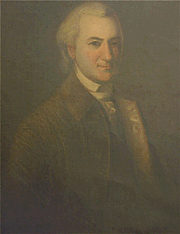
Sir John Dickinson, second Viceroy of the C.N.A.
The Viceroy was an office created by the Britannic Design of 1781 to serve as the executive officer of the Confederation of North America and chair meetings of the Grand Council. The office of Viceroy was included in the Design at the insistence of members of the House of Lords who wished to have a royal officer on hand in North America to defend British interests there. Lord North was able to win approval for the new office by letting it be known that he would appoint General John Burgoyne to fill it.
Burgoyne was installed as Viceroy on 2 July 1782, and he spent his time in office establishing good relations with the leaders of the confederations, making certain that elections were held according to law, and supervising the organization of the new government in Fort Pitt. After only fourteen months in office, Burgoyne fell ill and died in September 1783.
It was assumed at first that Burgoyne would be succeeded by the Lieutenant Viceroy, Lord Cornwallis. However, Lord North was able to persuade Parliament to select the Governor-General of the Northern Confederation, John Dickinson. At the same time, Dickinson was knighted, becoming Sir John Dickinson. Dickinson was installed as Viceroy on 1 February 1784. Dickinson was able to form a comfortable working relationship with Sir Charles Jenkinson, who succeeded North as Prime Minister in 1785. Dickinson served as Viceroy during the Trans-Oceanic War of 1795 - 99. Sobel does not say when Dickinson retired or died.
The only other Viceroy mentioned by Sobel is Sir Alexander Haven, who oversaw the Burgoyne Conference and the drafting of the Second Britannic Design. The Second Design created a new executive officer for the C.N.A., the Governor-General, who was chosen by a majority vote of the Grand Council. The office of Viceroy was retained to serve as a symbol of the C.N.A.'s ties with Britain, and would serve as interim Governor-General until one could be chosen by the Grand Council.
Following the death of Governor-General Henderson Dewey on 10 May 1929, Majority Leader John Jenckinson served as interim Governor-General rather than the Viceroy, which suggests that either the office of Viceroy was abolished between 1843 and 1929, or that the Viceroy in office at the time chose not to exercise his prerogative to serve as interim Governor-General. By the terms of the Reform Bill of 1936, passed in response to the 1929 succession crisis, the office of Council President was created to serve as a designated successor in case the Governor-General died or was incapacitated. The office of Viceroy may have been abolished by the Reform Bill, although this would have been out of character for Governor-General Douglas Watson.
In For All Nails, the office of Viceroy is abolished in 1976 following an attempt by the British Prime Minister to appoint his own candidate to the post.
